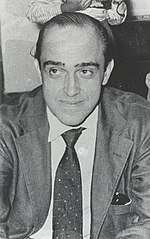
Architecture was my way of expressing my ideals: to be simple, to create a world equal to everyone, to look at people with optimism, that everyone has a gift. I don’t want anything but general happiness. Why is that bad?
Oscar Ribeiro de Almeida Niemeyer Soares Filho (December 15, 1907 – December 5, 2012) was a Brazilian architect who is considered one of the most important names in international modern architecture.
Quotes
Brasilia Cathedral, Brasilia, 1970
- First were the thick stone walls, the arches, then the domes and vaults — of the architect, searching out for wider spaces.
Now it is concrete-reinforced that gives our imagination flight with its soaring spans and uncommon cantilevers. Concrete, to which architecture is integrated, through which it is able to discard the foregone conclusions of rationalism, with its monotony and repetitious solutions.
A concern for beauty, a zest for fantasy, and an ever-present element of surprise bear witness that today's architecture is not a minor craft bound to straight-edge rules, but an architecture imbued with technology: light, creative and unfettered, seeking out its architectural scene.
- I have always accepted and respected all other schools of architecture, from the chill and elemental structures of Mies van der Rohe to the imagination and delirium of Gaudi. I must design what pleases me in a way that is naturally linked to my roots and the country of my origin.
- Quoted in "Gordon Bunshaft and Oscar Niemeyer: Pritzker Architecture Prize Laureates 1988", pritzkerprize.com (1988).
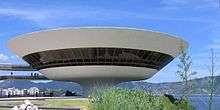
Niterói Contemporary Art Museum, Niterói, Brazil, 1996
- My work is not about "form follows function," but "form follows beauty" or, even better, "form follows feminine."
- Quoted in Tracy Metz, "'Form Follows Feminine': Niemeyer, 90, Is Still Going Strong," Architectural Record (December 1997), p. 35.
- I deliberately disregarded the right angle and rationalist architecture designed with ruler and square to boldly enter the world of curves and straight lines offered by reinforced concrete.… This deliberate protest arose from the environment in which I lived, with its white beaches, its huge mountains, its old baroque churches, and the beautiful suntanned women.
- The Curves of Time: The Memoirs of Oscar Niemeyer (2000), p. 62.
- I was attracted by the curve — the liberated, sensual curve suggested by the possibilities of new technology yet so often recalled in venerable old baroque churches.
- The Curves of Time: The Memoirs of Oscar Niemeyer (2000), p. 169

Here, then, is what I wanted to tell you of my architecture. I created it with courage and idealism, but also with an awareness of the fact that what is important is life, friends and attempting to make this unjust world a better place in which to live.
- Here, then, is what I wanted to tell you of my architecture. I created it with courage and idealism, but also with an awareness of the fact that what is important is life, friends and attempting to make this unjust world a better place in which to live.
- The Curves of Time: The Memoirs of Oscar Niemeyer (2000), p. 176.
- It is not the right angle that attracts me, nor the straight line, hard and inflexible, created by man. What attracts me is the free and sensual curve — the curve that I find in the mountains of my country, in the sinuous course of its rivers, in the body of the beloved woman.
- As quoted in Plans, Sections and Elevations : Key Buildings of the Twentieth Century (2004) by Richard Weston
- Variant translations:
It is not the right angle that attracts me,
Nor the hard, inflexible straight line, man-made.
What attracts me are free and sensual curves.
The curves in my country’s mountains,
In the sinuous flow of its rivers,
In the beloved woman’s body.- As quoted in "Architect of Optimism", Angel Gurria-Quintana, Financial Times (2007-04-13)
- It is not the right angle that attracts me.
nor the straight line, tough, inflexible,
created by man.
what attracts me is the free, sensual curve.
the curve I find in the mountains of my country,
in the sinuous course of its rivers,
in the waves of the sea,
in the clouds of the sky,
in the body of the favourite woman.
Of curves is made all the universe.
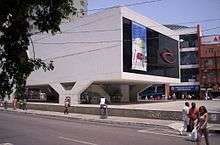
Municipal Library, Duque de Caxias, Brazil
- I had some good opportunities. I was lucky to have had the chance to do things differently. Architecture is about surprise.
- Quoted in "Architect of Optimism," Angel Gurria-Quintana, Financial Times (2007-04-13).
- My ambition has always been to reduce a building’s support to a minimum. The more we diminish supporting structures, the more audacious and important the architecture is. That has been my life’s work.
- Quoted in "Architect of Optimism," Angel Gurria-Quintana, Financial Times (2007-04-13).

Memorial da América Latina, São Paulo, Brazil, 1987
- Life is very fleeting. It’s important to be gentle and optimistic. We look behind and think what we’ve done in this life has been good. It was simple; it was modest. Everyone creates their own story and moves on. That’s it. I don’t feel particularly important. What we create is not important. We’re very insignificant.
- Quoted in "Why Oscar Niemeyer is king of curves", Tom Dyckhoff, The Times Online (London, 2007-12-12).
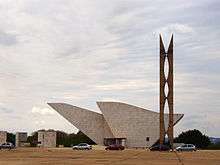
Homeland Pantheon, Brasilia, 1985
- We hated Bauhaus. It was a bad time in architecture. They just didn’t have any talent. All they had were rules. Even for knives and forks they created rules. Picasso would never have accepted rules. The house is like a machine? No! The mechanical is ugly. The rule is the worst thing. You just want to break it.
- Quoted in "Why Oscar Niemeyer is king of curves," Tom Dyckhoff, The Times Online (London, 2007-12-12).
- Architecture was my way of expressing my ideals: to be simple, to create a world equal to everyone, to look at people with optimism, that everyone has a gift. I don’t want anything but general happiness. Why is that bad?
- Quoted in "Why Oscar Niemeyer is king of curves", Tom Dyckhoff, The Times Online (London, 2007-12-12).
- Quoted in "Why Oscar Niemeyer is king of curves", Tom Dyckhoff, The Times Online (London, 2007-12-12).
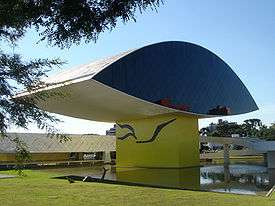
Oscar Niemeyer Museum, Curitaba, Brazil, 2002
External links
- Niemeyer in Brasília history
- Oscar Niemeyer Museum (in Portuguese)
- Contemporary Art Museum, Niteroi
- Photos of the Museum of Contemporary Art
- Pritzker Prize 1988
- "Challenging the Hierarchies of the City: Oscar Niemeyer’s Mid-Twentieth-Century Residential Buildings by Styliane Philippou
- Oscar Niemeyer's Strick House in Santa Monica
- Pampulha church in Google Earth
This article is issued from
Wikiquote.
The text is licensed under Creative
Commons - Attribution - Sharealike.
Additional terms may apply for the media files.